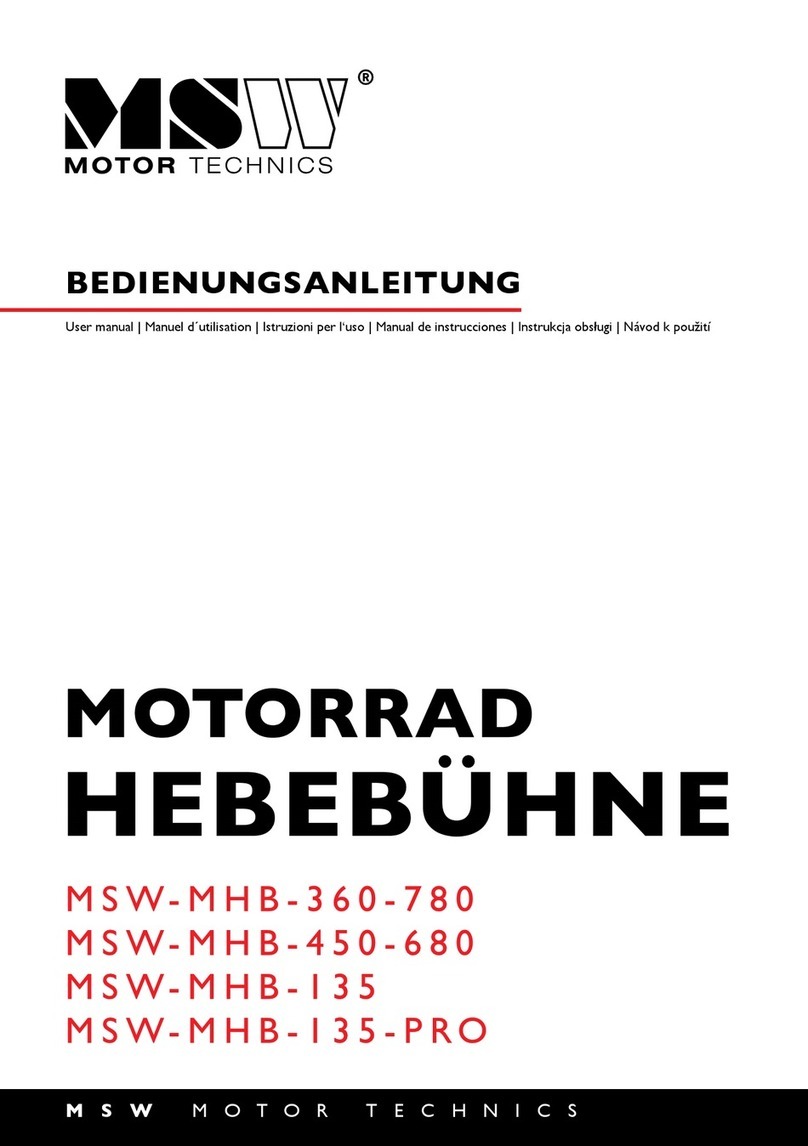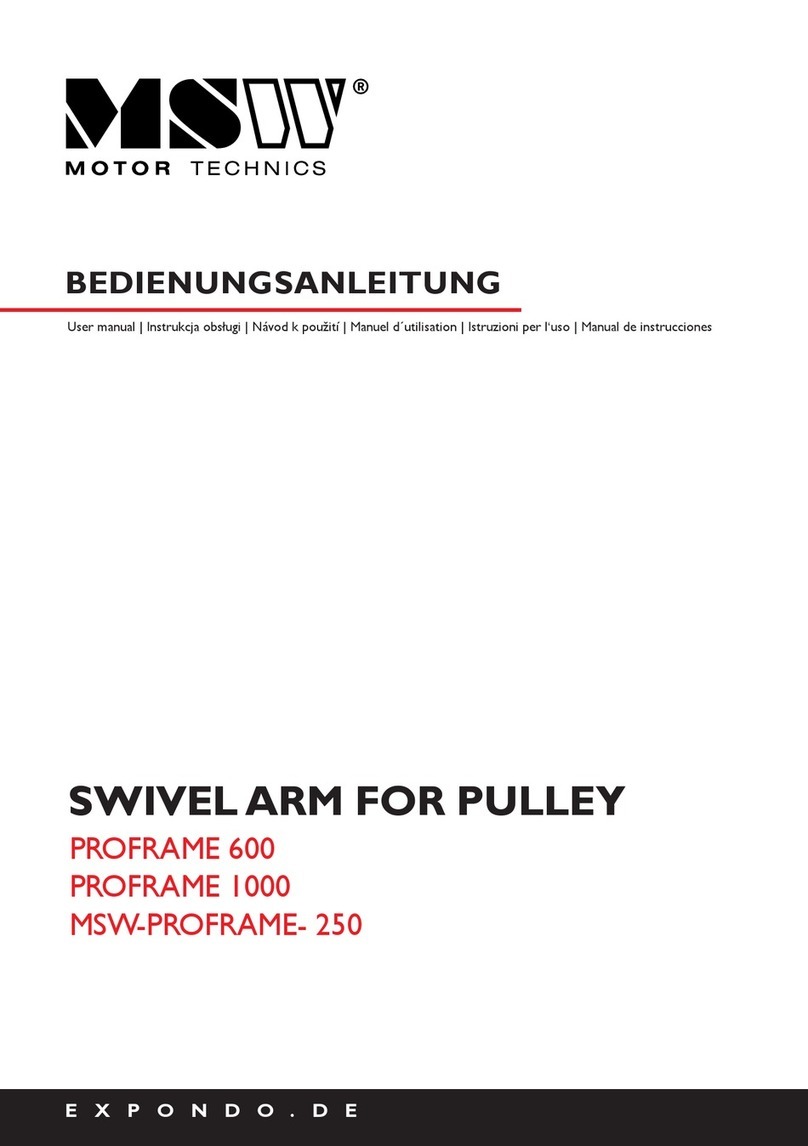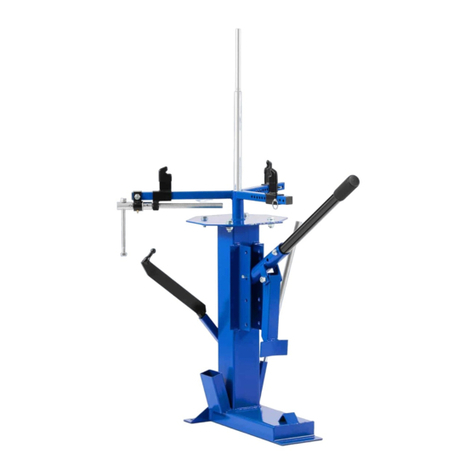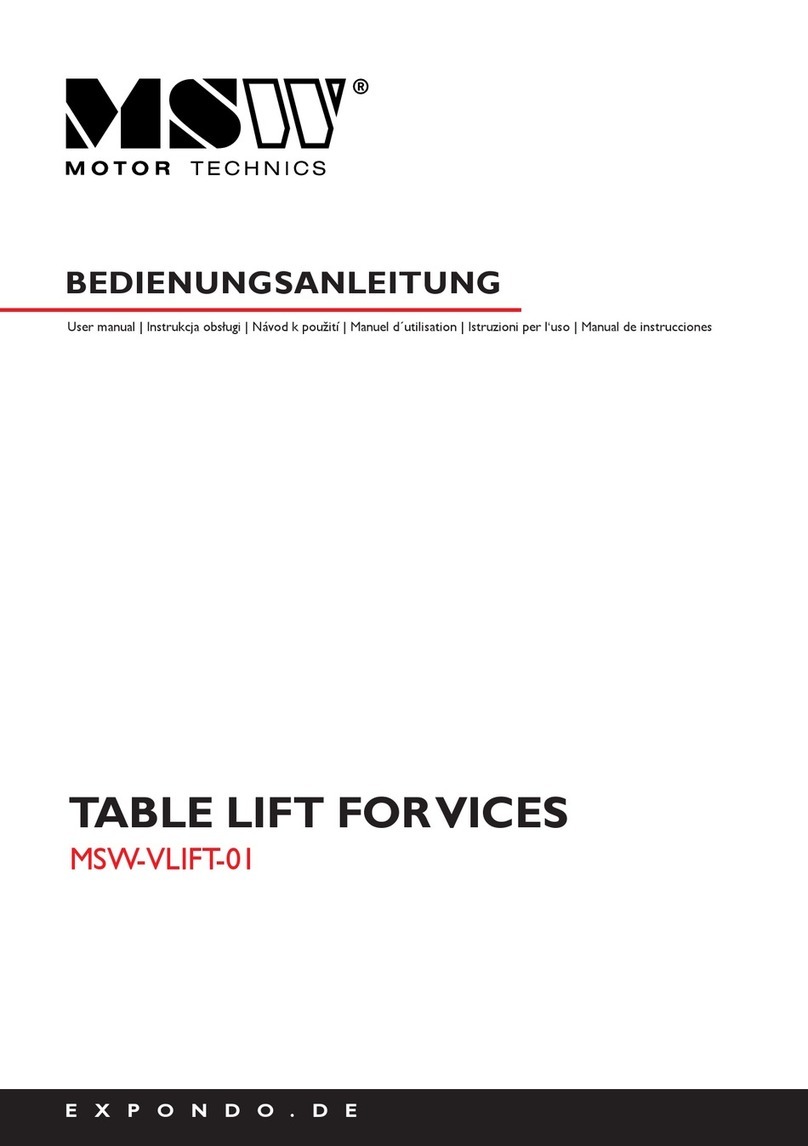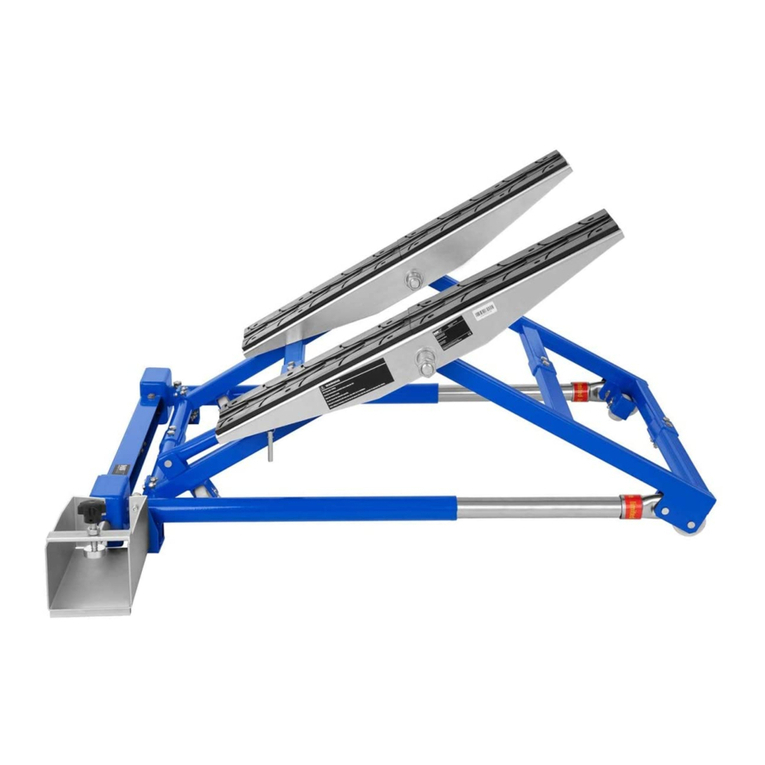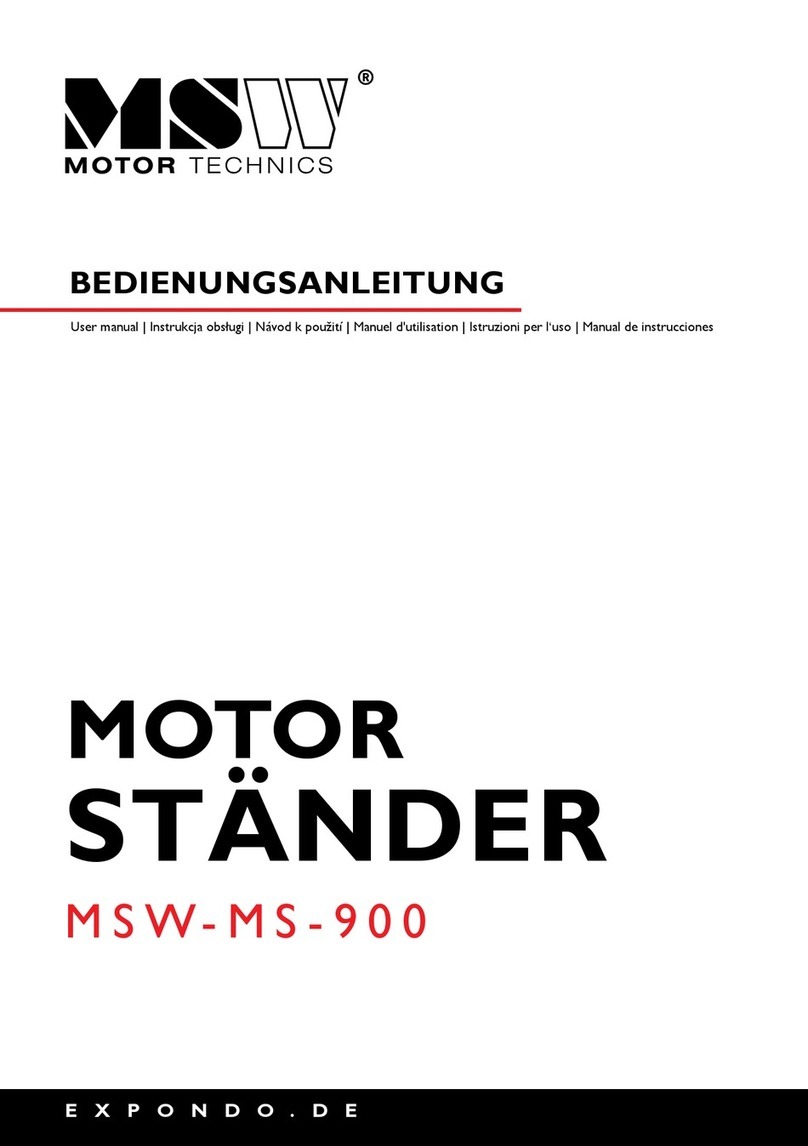
1234
5
6
7
8
9
13. Verboten ist das Lastanheben unter Verwendung der Maschine über Menschen oder Tieren.
14. Die Last ist immer zu beobachten.
15. Verboten ist, die Last ohne Aufsicht zu hinterlassen.
16. Man darf die zulässige Tragfähigkeit des Hubgeräts nicht überschreiten.
17. Man darf die Maschine nicht mit einer Last lagern.
18. Man darf nur eine Ladung auf einmal heben.
19. Es dürfen keine Modizierungen an der Maschine vorgenommen werden.
20. Nach dem Abschluss des Betriebs ist die Maschine gegen unbefugte Benutzung abzusichern.
21. Die Maschine muss regelmäßig überprüft werden, beschädigte oder abgenutzte Bestandteile müssen
durch die zuständige Service-Stelle gegen neue ausgetauscht werden.
22. Beim Herunterfallen der Last entsteht Todes- oder Verletzungsrisiko.
23. Wird der Motorradheber über längere Zeit nicht verwendet wird, ist sicher zu stellen, dass er sauber
ist, keine Verschmutzungen aufweist und das der Sattel in die niedrigste Position gebracht wurde. Das
Gerät darf nicht mit Feuchtigkeit in Kontakt kommen, ggf. ist es trocken zu reiben, danach sämtliche
beweglichen Teile schmieren.
24. Die Beladung sollte stets mit einer Kette gesichert werden.
25. Die Maschine darf ausschließlich auf einer achen, horizontalen und der Belastung angepassten
Oberäche verwendet werden.
26. Die Beladung sollte stets gut ausgewogen sein. Die Empfehlungen des Motorradherstellers bezüglich
der Motorradhebepunkte müssen befolgt werden.
27. Es ist untersagt, den Motorradheber zusammen mit der Beladung zu verlegen/zu transportieren! Ein
Verlegen / Transport darf ausschließlich ohne Beladung erfolgen.
28. Nähern Sie nie die Hände oder Beine dem Arbeitsbereich.
29. Es ist untersagt, die Maschine zu verändern. Es ist untersagt, die Maschine zu verwenden, wenn
sichtbare Beschädigungen vorliegen, die Verformung von Teilen, Risse oder andere Defekte, die eine
ordnungsgemäße Verwendung unmöglich machen.
30. Vor Verwendung der Maschine muss überprüft werden, ob alle Schrauben fest angezogen sind.
Werden die Anweisungen und Sicherheitshinweise verletzt kann das zu ernsthaften Körperverletzungen
oder zum Tod führen.
III. MASCHINENBESTIMMUNG
Der Motorradheber dient ausschließlich zum Anheben von Motorrädern. Eine Verwendung zu anderen
Zwecken ist untersagt.
Für alle Schäden bei nicht bestimmungsgemäßer Verwendung haftet allein der Benutzer.
IV. TECHNISCHE DATEN
Produktname Motorradhebebühne
Modell MSW-MHB-450-780.1 MSW-MHB-450-780.2 MSW-MHB-450-780.3
Katalognummer 6318 6319 6320
Maximal zulässige Belastung (lbs/kg) 450 450 450
Maximale Höhe (cm) 78 78 78
Minimale Höhe (cm) 18 18 18
Gewicht (kg) 120 138 140
Plattformgröße (cm) 206 x 55 220 x 68 220 x 68
Größe der Auauframpe (cm) 60 x 55 60 x 68 60 x 68
V. VOR DER ERSTEN BENUTZUNG
Prüfen Sie bei Erhalt der Ware zuerst die Verpackung auf Unversehrtheit und öffnen Sie diese dann. Wenn die
Verpackung Beschädigungen aufweist, so setzen Sie sich innerhalb von 3 Tagen mit der Transportgesellschaft
und Ihrem Vertriebspartner in Verbindung und dokumentieren Sie so gut wie möglich die Beschädigungen.
Stellen Sie das volle Paket nicht verkehrt herum auf! Sollten Sie das Paket weiter transportieren, achten Sie
bitte darauf, dass es horizontal und stabil gehalten wird. Es wird darum gebeten, das Verpackungsmaterial
(Pappe, Plastikbänder und Styropor) zu behalten, um im Servicefall die Maschine bestmöglich geschützt
zurücksenden zu können!
VI. ZUSAMMENBAU DER MASCHINE
MSW-MHB-450-780.1 (6318) | MSW-MHB-450-780.2 (6319) | MSW-MHB-450-780.3 (6320)
4Rev. 02.02.2017 5
Rev. 02.02.2017
1. Rad
2. Fußhebel - Entriegelung
3. Fußhebel - Anhebevorrichtung
4. Pumpe
5. Aufrolläche
6. Plattform
7. Montagehalterungen – Motorrad:
8. Feststeller
9. Begrenzer
Vor dem Gebrauch muss überprüft werden, ob Gewicht und Größe des Motorrads nicht die nominale
Tragkraft des Hebers übersteigt.
Vor der Inbetriebnahme zum Anheben ist die Hebevorrichtung vor unbeabsichtigtem Wegrutschen zu
sichern.
Den Motorradheber nur auf stabilen und ebenen Flächen verwenden.
Den Motorradheber nur ohne Beladung transportieren; die Plattform sollte auf das unterste Level
abgelassen werden.
Der Heber kann nur auf einer stabilen und trockenen Oberäche verwendet werden, die nicht rutschig und
in der Lage ist, das Gesamtgewicht des Aufzugs und der Last zu tragen. Das Gerät muss sauber gehalten
werden. Keine Gegenstände darauf lagern, die bei der Arbeit nicht erforderlich sind.
Das Motorrad muss sicher und fest auf der Plattform angebracht werden. Hierzu die Befestigungsriemen
verwenden und diese an den Halterungen des Hebers befestigen.
Vor dem Ablassen der Plattform alle sich darunter bendenden Gegenstände entfernen. Alle Personen
sollten sich während des Betriebs des Hebers in sicherem Abstand benden.
Es ist untersagt, den Heber oder die Plattform zum Transport von Gegenständen zu verwenden. Das Gerät
ist ausschließlich zum stationären Gebrauch gedacht - zum Anheben von Gegenständen. Die angehobene
Beladung muss stets stabil sein.
Sämtliche Reparaturen müssen von qualiziertem technischen Personal durchgeführt werden; die
Austauschteile müssen Originalteile und vom Hersteller des Gerätes zugelassen sein.
Der Motorradheber muss auf einem festen und ebenen Untergrund aufgestellt werden, welcher
das Gesamtgewicht der Last (Heber zusammen mit der Beladung) halten kann. Der Heber ist gegen
unbeabsichtigtes Wegrutschen oder Verschieben zu sichern.
Die Beladung (Motorrad) auf der Plattform unterbringen und sichern, indem das Vorderrad des
Motorrads in dem Schraubstock befestigt wird. Befestigen sie das Motorrad auch mit den Riemen /
Befestigungskomponenten.
Die Plattform durch energisches Pumpen des Fußhebels anheben. Wenn die Plattform in der gewünschten
Höhe ist, die Sicherungsstange in eine der Öffnungen in der Plattform schieben. Dies ist eine Absicherung
gegen zufälliges Absacken oder Verschieben:












